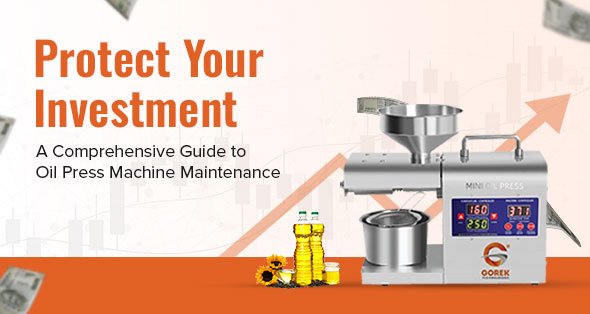Protect Your Investment: A Comprehensive Guide to Oil Press Machine Maintenance

Your home oil press machine is more than just an appliance; it’s a gateway to healthier eating, enabling you to enjoy pure, fresh oils right in your kitchen. It’s a valuable investment in your well-being and culinary adventures. But, just like any precision tool, its longevity and efficiency depend heavily on proper care. Think of it as nurturing your culinary workhorse so it can continue to serve you, producing those golden drops, for years to come.
This guide will walk you through essential maintenance tips, ensuring your oil press machine performs optimally and stands the test of time.
Immediate Post-Pressing Care
The moment you’ve finished pressing your oil, your maintenance routine begins. This immediate care is crucial to prevent oil residue from hardening and becoming difficult to remove.
Safety First: Always Unplug! Before you do anything, ensure your machine is completely unplugged from the power outlet. Safety is paramount when handling any electrical appliance.
Disassemble and Clean While Warm: Oil residues are far easier to clean when the machine is still slightly warm, but not hot enough to burn you. Immediately disassemble the pressing chamber, the auger (that screw-like mechanism that pushes the seeds), and any filter components. Don’t let the residue cool and harden!
Scrape and Wipe Away Residue: Use the cleaning brush or small scraper often provided with your machine to gently remove the solid “cake” residue from the pressing chamber and auger. This initial scraping makes the washing process much simpler.
Warm Soapy Water & Gentle Cleansers: Wash these disassembled parts with warm, soapy water using a mild dish soap. Avoid harsh abrasives, scouring pads, or strong chemical detergents, as these can scratch surfaces or leave behind harmful residues that could affect future oil quality. For any stubborn spots, a soft brush or sponge will usually do the trick.
Rinse Thoroughly and Dry Immediately: After washing, rinse all components meticulously to ensure no soap residue remains. Then, here’s a critical step: ensure all components are thoroughly dry. Moisture is the enemy of metal parts and can quickly lead to rust or even bacterial growth. Ideally, air-dry completely on a drying rack or wipe them down with a clean, lint-free cloth within 15-30 minutes of washing to prevent rust formation.
Regular Deep Cleaning and Inspection
Beyond the immediate post-use cleaning, a deeper dive into maintenance every few uses or weekly (if you’re a frequent oil presser) will keep your machine in top shape.
Wipe Down the Motor Unit: Remember, the main motor unit is an electrical component and should never be immersed in water. Instead, use a slightly damp cloth to wipe down the exterior, removing any dust or oil splatters.
Clear Ventilation Ports: Your machine’s motor needs to breathe! Dust and fine oil mist can accumulate in the ventilation ports, leading to overheating. Periodically use a soft brush or a can of compressed air to gently clear these vents.
Inspect Components for Wear: Take a moment to inspect the auger and the inner pressing chamber. Look for any signs of wear, such as nicks, grooves, or even subtle changes in color that might indicate metal fatigue. Rust spots, no matter how small, should be addressed immediately. If you notice any unusual noises during operation, it’s often a subtle sign that a component needs attention or replacement.
Lubrication (If recommended): This is a crucial point: only lubricate if your manufacturer’s manual specifically recommends it. For machines with metal gears or bearings that require it, consult your manual carefully; some manufacturers recommend applying a food-grade lubricant every 3-6 months. Using the wrong type of lubricant can damage your machine or contaminate your oil.
Storage Best Practices
How you store your machine matters just as much as how you clean it.
Always Store Clean and Dry: Before putting your machine away for any length of time, ensure all parts are spotlessly clean and bone dry.
Dismantled or assembled? Your user manual will be your best guide here. Some manufacturers recommend storing components disassembled to allow for better air circulation and prevent moisture traps, while others are fine with assembly.
Choose the Right Location: Store your oil press in a cool, dry place away from direct sunlight, extreme temperatures, and high humidity. Avoid damp basements, garages, or areas prone to significant temperature fluctuations, as these can accelerate wear and tear. A kitchen cabinet or pantry shelf is usually ideal.
The Simple Dust Cover: Even a simple cloth cover can make a big difference. It prevents dust and debris from accumulating on the machine, especially around the motor area and crevices, saving you cleaning time before your next pressing session.
Troubleshooting Common Issues
While comprehensive care prevents most problems, sometimes issues arise. Always refer to your user manual first for specific troubleshooting.
- Low Oil Yield: This could be due to inadequate cleaning, using the wrong type of seeds, or components showing signs of wear.
- Excessive Noise: Often indicates something is loose, improperly assembled, or a part might be worn and needs attention.
- Machine Not Starting: Double-check power connections and ensure all components are correctly assembled and locked into place as per your manual.
For any persistent or complex issues, don’t hesitate to contact the manufacturer’s customer support.

